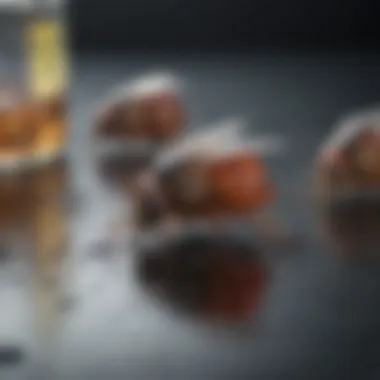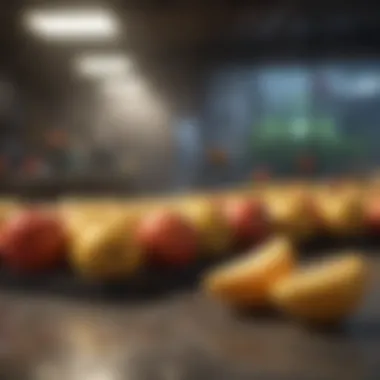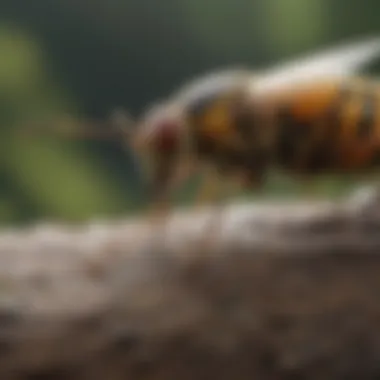Natural Ways to Eliminate Fruit Flies Naturally


Intro
Fruit flies, often regarded as mere annoyances, can create significant challenges in households and businesses alike. Their attraction to ripe or decomposing fruits makes them a common sight in kitchens and dining areas. Understanding their behavior and natural elimination methods is essential not just for comfort but also for hygiene. This article provides insightful and effective natural strategies to manage fruit fly populations without compromising food safety or the environment.
Fascinating Facts About the Animal
Unique Characteristics
Fruit flies, specifically Drosophila melanogaster, are small insects typically measuring about 1/8th of an inch long. Despite their size, their reproductive capacity is remarkable. A single female can lay up to 500 eggs in her short lifespan, leading to rapid population growth. They have a distinct reddish-brown body with big, red eyes, which are not just for show. Their eyes have specialized ommatidia, allowing them to detect movement swiftly.
Extraordinary Abilities
These creatures possess extraordinary olfactory senses, which enable them to smell ripe fruits from significant distances. This sensitivity is not just for finding food; it plays a critical role in their communication and mating behaviors. Moreover, their adaptability has led them to thrive in a variety of environments, from farms to urban households.
Behavior and Habitat
Natural Habitats
Fruit flies prefer warm and humid environments, which is why they are commonly found in kitchens. They are particularly active in areas with an abundance of overripe or decaying fruits and vegetables. Such locations offer ideal breeding grounds for their larvae, which develop in decaying organic material. Their presence signifies not only the availability of food sources but also potential hygiene issues that need attention.
Social Structures
Although fruit flies do not have a social structure like bees or ants, they do exhibit fascinating behaviors in mating and feeding. Male fruit flies engage in complex courtship displays, utilizing sound and pheromones to attract females. These behaviors highlight their reliance on olfactory cues and sound as means of communication in the wild.
Recent Scientific Discoveries
Latest Research Findings
Recent research has focused on the role of fruit flies in scientific studies, particularly in genetics and neurobiology. Their simple genetic structure makes them ideal for studying inherited traits and memory models. Findings suggest that genes involved in their sensory perception are crucial for understanding neural mechanisms, highlighting their potential impact on broader biological research.
Breakthroughs in Animal Biology
There have been significant breakthroughs in utilizing fruit flies as models for human disease research. Studies on Drosophila have contributed to the understanding of neurodegenerative diseases like Alzheimer's, showcasing their importance beyond pest control.
Cultural Significance
Animals in Folklore
Fruit flies may not feature prominently in folklore, yet their nuisance status in homes has inspired various myths about cleanliness and health. Some cultures hold superstitions about the presence of fruit flies being a bad omen, often linked to food spoilage.
Influence on Art and Literature
In literature, fruit flies represent decay and the fleeting nature of life, often found in works that explore themes of mortality. Their presence can signal moments of transformation, whether in cooking, fermentation, or decomposition, highlighting relationships between humans and the natural world.
Fruit flies are more than just pests; they are intricate organisms whose behaviors and characteristics are pivotal in various biological studies.
By comprehending the ecology of fruit flies, we can devise effective natural methods for their control. This insight lays the groundwork for the strategies discussed in the subsequent sections of the article.
Understanding Fruit Flies
Understanding fruit flies is crucial in managing their populations effectively. These pests thrive in environments rich in decomposing fruits and vegetables, making their understanding vital for households and food establishments. Gaining insight into their life cycle and behavior not only aids in their elimination but also enhances food safety and hygiene. A well-informed approach allows for prevention strategies that reduce the likelihood of infestations, ensuring a healthier environment for families and individuals alike.
The Life Cycle of Fruit Flies
The life cycle of fruit flies consists of four main stages: egg, larva, pupa, and adult. Female fruit flies can lay up to 500 eggs in just a few days, typically on the surface of fermenting fruit or vegetables. These eggs hatch within 24 to 30 hours into larvae, which then feed on the decaying material. This larval stage lasts about four to seven days, where growth and development occur.
After feeding, larvae burrow into the substrate to pupate. This pupal stage lasts around four to five days. Once mature, the adult emerges, ready to begin the cycle again. Understanding this cycle is essential in targeting pest control efforts effectively. Eliminating breeding sites and fruit that attract these flies helps disrupt their reproduction.


Behavioral Patterns
Fruit flies exhibit several significant behaviors that influence their population dynamics. They are particularly attracted to the scent of overripe or fermenting fruits. This attraction stems from their need to find food sources for reproduction and sustenance.
Fruit flies are social insects, often found in groups. Their propensity to thrive in large numbers highlights the importance of early detection. Additionally, these pests can reproduce rapidly, leading to exponential increases in their populations. Awareness of their behavioral patterns can aid in devising strategies that involve removing potential food sources and breeding grounds promptly.
Effective management practices require understanding both the life cycle and behavioral patterns of fruit flies. Targeting their breeding sources and food attractions is key to sustainable pest control.
Identifying Fruit Flies
Identifying fruit flies is crucial for effective pest management. Misidentification can lead to inadequate strategies that fail to control the population. Knowing how to spot these pests allows individuals to adopt appropriate natural elimination methods. Understanding both physical characteristics and signs of infestation can help mitigate potential issues before they escalate.
Physical Characteristics
Fruit flies, scientifically known as Drosophila melanogaster, are small insects, typically measuring about 1/8 inch in length. They have a distinct tan or light brown body, with large red eyes, which can often be a dead giveaway when spotting them. Under magnification, their body is seen to have a smooth appearance with a slight sheen, and they possess a pair of wings that can flicker rapidly.
Additionally, the overall size and shape can vary slightly based on their environment. Their larvae, commonly referred to as maggots, are small, white, and legless, often found near decaying fruit—not easily mistaken for other pests if you know what to look for.
Common Signs of Infestation
Detecting signs of fruit fly infestation is straightforward but requires vigilance. Here are some indicators you should watch for:
- Presence of Adult Flies: Seeing small flies around fruit or in the kitchen is often the first sign.
- Larvae Development: Finding small, white maggots near rotting or fermenting food indicates a breeding ground.
- Odor: A fruity smell around domestic spaces can suggest that fruit flies are nearby, attracted to decaying matter.
- Food Sources: Spotting fruit flies congregating around overripe or damaged fruits can indicate that breeding may be occurring there.
"The sooner you identify fruit flies, the easier it is to manage and eliminate them naturally."
By recognizing these physical traits and signs, individuals can respond quickly. This approach helps protect food safety and maintains a hygienic environment, which is especially important in shared living spaces and food preparation areas.
Natural Elimination Methods
Natural elimination methods are essential for dealing with fruit flies effectively and sustainably. These methods not only target the flies directly but also minimize any harm to the environment. Traditional chemical solutions can have adverse effects on health and the ecosystem. Hence, using natural strategies is becoming increasingly popular among those looking for safer and more eco-friendly options. Alternative methods often include the use of essential oils, vinegar traps, fruit baits, and biological control agents. Each approach has its own merits, and understanding them helps in choosing the most effective ones for your needs.
Essential Oils
Essential oils have gained traction as a natural remedy for insect problems, including fruit flies. Their strong scents can confuse and repel these pests, making them a popular choice for pest management.
Types of Essential Oils
Several types of essential oils can be effective against fruit flies. Some of the most common choices include lavender, peppermint, and eucalyptus. Each of these oils has a distinct aromatic profile that disrupts the flies�’ ability to navigate effectively. The key characteristic of these essential oils is their natural insect-repelling properties.
Lavender oil not only smells pleasant but also acts as a repellent due to its chemicals that target the olfactory receptors of the flies. Peppermint oil is known for its strong menthol scent, which can deter various insects, including fruit flies. Eucalyptus oil has a robust scent that is particularly effective in keeping flies at bay. These oils are beneficial choices in this article since they provide a natural alternative without introducing harmful substances into the environment.
However, it is also important to note that essential oils need to be used correctly. Some might cause skin irritation if used directly. Proper dilution and application can mitigate these disadvantages.
Application Techniques
The way essential oils are applied plays a crucial role in how effective they are against fruit flies. Common application techniques include diffuseing oils in a space with a diffuser, using wood balls soaked in the oils placed around infested areas, or creating spray mixtures for direct application. This flexibility in application makes essential oils a popular choice.
The unique feature of application techniques lies in their ease of use and adaptability. They can be incorporated into existing cleaning routines or even integrated into air fresheners, enhancing both pest control and home ambiance. Like any method, some individuals may experience sensitivities or allergies to certain oils, which is a consideration to be aware of when using them.
Vinegar Traps
Vinegar traps have proven to be an effective method in capturing and reducing fruit fly populations. The presence of vinegar attracts the flies, which can then be trapped and eliminated.
How to Create a Vinegar Trap
Creating a vinegar trap is straightforward and requires minimal materials. Generally, a jar or bowl filled with apple cider vinegar and a drop of dish soap is enough to lure and trap fruit flies. The apple cider vinegar’s sweet scent draws the flies in, and the dish soap breaks the surface tension of the liquid, preventing them from escaping.


The unique aspect of this method is its simplicity and effectiveness. It provides a way to deal with fruit flies without complicated setups. The potential disadvantage, however, is that vinegar traps mainly capture adult flies. To fully address an infestation, additional strategies may be required to target larvae.
Best Practices for Effectiveness
For vinegar traps to be effective, specific best practices should be followed. Placing traps in areas where fruit flies are most active, such as kitchens or near garbage, increases their efficiency.
Additionally, ensuring that the traps are checked regularly will prevent overflow of captured flies, which can diminish effectiveness. Regularly replacing the vinegar to maintain its scent and stickiness is also necessary. While simple, these best practices enhance the overall utility of vinegar traps in managing fruit fly problems.
Fruit Baits
Using fruit baits is another practical, natural method to control fruit flies. Overripe or spoiled fruits are particularly effective in drawing in fruit flies.
Choosing the Right Bait
When selecting fruit baits, it is essential to choose the right kinds of fruit. Materials like bananas, peaches, or apples work well due to their strong scent and sweetness. The key characteristic of choosing the right bait lies in their natural appeal to fruit flies.
Using ripe or decomposing fruit is often a beneficial choice since it can effectively lure flies. However, one must manage these baits regularly to avoid further fostering of flies and ensure that the bait does not become a breeding ground itself.
Setting Up Fruit Baits
Setting up fruit baits requires only a few steps. Simply place the chosen fruit in a bowl or jar, and leave it in the infested area. A covering option with plastic wrap with small holes allows easy access for fruit flies while trapping them. This method is advantageous in simplicity and effective retrieval of flies.
However, decay of the fruit can lead to additional odor problems if left unchecked, so regular monitoring and changing of the bait is vital to maximize effectiveness.
Biological Control
Biological control represents an environmentally responsible approach to pest management. This involves using natural predators that target fruit flies and help to keep their populations at bay.
Predatory Insects
Predatory insects like Hypoaspis miles and other beneficial insects can be used to tackle fruit fly problems. These predators feed on larvae and adult fruit flies, directly impacting their populations. The main benefit of using predatory insects is their natural behavior, which promotes ecological balance.
However, finding the right predator for the specific type of fruit fly can be challenging, as not all predators target all varieties. Furthermore, introducing new insects into the environment requires careful consideration of ecological compatibility.
Nematodes as Control Agents
Nematodes, microscopic worms, can also serve as effective biocontrol agents against fruit flies. When applied to the soil or infested materials, they penetrate and kill larvae. This method highlights the unique ability of nematodes to reduce populations at the larval stage, preventing future infestations.
The effectiveness of nematodes lies in their host-specific nature, which means they target fruit fly larvae without harming beneficial organisms. One challenge might include the need for proper environmental conditions for nematodes to thrive. Overall, incorporating biological controls requires an understanding of local ecosystems and careful application to maintain a healthy balance.
Preventive Strategies
Preventive strategies are crucial in managing fruit fly populations effectively. By addressing the conditions that allow these nuisances to thrive, we can reduce their numbers considerably. Implementing proper waste management, practicing effective food storage, and maintaining cleanliness in the home environment all contribute significantly towards a fruit fly-free space. Moreover, these strategies not only aim at immediate results but foster a long-term solution that incorporates sustainability and hygiene.
Waste Management
Proper Disposal Methods
Proper disposal methods are vital for controlling fruit fly populations. This involves discarding food waste and any potential breeding grounds promptly. A key characteristic of these methods is the immediate removal of organic material, which attracts fruit flies. Proper disposal methods are beneficial in preventing the accumulation of waste that could serve as a breeding ground. One unique feature is the use of sealed containers for waste, which can minimize smells that lure these pests. The advantage of this method lies in its straightforward implementation, making it a preferred choice for any household struggling with fruit fly issues. However, the disadvantage could be mismanagement, where the waste becomes too full, leading to odors that continue to attract flies.
Composting Guidelines
Composting guidelines provide an eco-friendly approach to waste management while contributing to pest control. This method allows for the recycling of organic materials, turning waste into valuable compost. A key characteristic is the ability to manage composting bins effectively to ensure they do not become a breeding site for fruit flies. Compost bins should be well-ventilated and maintained at appropriate moisture levels. One unique feature of composting is that when done properly, it does not attract unwanted pests. An advantage of this method is that it promotes sustainability. On the downside, improper composting practices can lead to foul odors and fruit fly infestations, thus requiring mindful attention and management.
Food Storage Best Practices
Storing Fruits and Vegetables


Storing fruits and vegetables properly is fundamental to preventing fruit flies from establishing themselves in the home. The objective is to create conditions that hinder their access to potential food sources. A key characteristic of proper storage is placing produce in a cool, dry place. For instance, storing ripe fruits in the refrigerator can be quite advantageous since it makes them less accessible to fruit flies. The unique feature of this practice lies in how it can extend the freshness of produce as well. However, a disadvantage may emerge if people forget to check for overripe items that attract flies, hence necessitating regular inspections.
Sealing Techniques
Sealing techniques involve securing food containers to prevent insect access. These techniques focus on using tight-fitting lids or resealable bags. A key characteristic is that it minimizes exposure to fruit flies and other pests. This method is beneficial since it protects not only fruits but also other food items from contamination. One unique feature of sealing food is that it preserves the quality and freshness, thus reducing food waste. Nevertheless, improper sealing can lead to gaps where flies might still enter, so attention needs to be paid to ensuring that containers are tightly closed.
Home Environment Sanitation
Cleaning Surfaces
Cleaning surfaces regularly is essential to eliminate potential food sources for fruit flies. This method focuses on maintaining cleanliness in areas where food is prepared or consumed. The key characteristic is to use proper cleaning agents that can both remove debris and sanitize the surfaces. This routine is a beneficial practice because it substantially decreases the likelihood of attracting flies. A unique feature of this approach is that it can prevent other pests from invading. However, failing to clean regularly can render this method ineffective and ultimately attract more pests.
Regular Cleaning Routines
Establishing regular cleaning routines provides an organized approach to maintaining a fruit fly-free environment. This demands a commitment to daily or weekly cleaning tasks. The key characteristic of following a routine is that it ensures no area is neglected. This practice is advantageous as it builds momentum in keeping homes tidy and less attractive to pests. A unique aspect of regular cleaning is that it fosters overall hygiene in the home. On the downside, it may require dedicated time and effort, which can be a challenge for some households.
Assessing Effectiveness of Methods
Assessing the effectiveness of methods for eliminating fruit flies plays a critical role in pest management. It ensures that chosen strategies are indeed functioning as intended, hence avoiding further infestations. Moreover, it can aid in refining approaches, thus enhancing overall efficacy. Understanding the relative success of different methods enables a more systematic and evidence-based approach.
Monitoring is essential in establishing a feedback loop that informs ongoing strategy adjustments. Each method can yield varying results, depending on the environment, fly population, and available resources. Thus, continuous assessment becomes necessary to ascertain which methods are providing the desired outcomes effectively.
Monitoring Fly Populations
Monitoring fly populations goes beyond mere observation. It involves implementing specific techniques to gauge population density and activity patterns. Regular checks can help determine if the population is increasing, decreasing, or remaining stable. This data is vital for the evaluation of the implemented strategies.
Here are a few ways to monitor fruit fly populations:
- Trap Counts: Use traps, such as vinegar traps or commercial sticky traps, to collect samples. Regularly count the number of flies caught to track changes over time.
- Visual Inspection: Maintain a vigilant watch over areas such as fruit bowls, kitchen counters, and compost bins. Signs of increased activity may indicate the need for immediate action.
- Infestation Reports: Pay attention to reports and experiences shared in communities such as reddit.com. Engaging with others can provide insights on the social environment affecting fly populations.
The duration and frequency of monitoring may vary, but consistent practices help clarify whether current strategies are effective.
Adjusting Strategies Based on Observations
Adjusting strategies based on observations is crucial for successful pest control. Once monitoring reveals data on fly populations, it can inform necessary modifications to current practices.
Here are some considerations for making adjustments:
- Increase Trap Numbers: If fly counts remain high, adding more traps can improve capture rates. This is especially true in crowded areas where flies may be more numerous.
- Vary Attractants: Depending on the results, it may help to explore different bait options, such as switching from vinegar to fruit baits or essential oils.
- Enhance Sanitation Practices: A decrease in cleanliness might necessitate a re-evaluation of waste management and food storage practices.
Incorporating feedback and being flexible in your approach can lead to more effective pest management strategies. As you gather insights from your findings, effectiveness will improve, ensuring that the issue does not escalate.
"To win the battle against fruit flies, be observant, be adaptive."
Overall, assessing effectiveness through monitoring and adjustments creates an iterative process that enhances the sustainability and efficiency of natural fruit fly elimination methods.
End
When dealing with fruit flies, understanding the importance of natural methods becomes crucial. This article highlights various strategies that not only effectively control fruit fly populations but also promote a more environmentally friendly approach to pest management. Implementing these methods can significantly reduce the presence of these pests in your kitchen and living areas.
Summary of Natural Methods
Throughout this article, several natural methods were discussed. These methods include:
- Essential Oils: Oils like peppermint or eucalyptus can deter fruit flies due to their strong scents.
- Vinegar Traps: A simple yet effective solution, using apple cider vinegar in a trap can attract and trap these flies.
- Fruit Baits: Overripe fruits can be utilized as bait in traps, allowing for the capture of adult flies.
- Biological Control: Introducing natural predators can help keep fruit fly populations in check.
Each of these methods demonstrates a practical approach to managing fruit flies without chemicals, maintaining a clean environment that is safe for humans and pets alike.
Emphasis on Sustainability
Focusing on sustainability is more than a trend; it is a necessity. Utilizing natural methods to eliminate fruit flies supports ecological balance and reduces reliance on synthetic pesticides. Such approaches minimize the risks linked to chemical insecticides, which can have harmful impacts on both human health and the environment.
Incorporating sustainability in pest management means considering long-term effects. Encouraging biodiversity through biological controls or opting for traps that do not involve chemicals creates a safer habitat. This way, we not only manage current fruit fly invasions but also contribute to a healthier ecosystem for future generations.
Emphasizing sustainable pest management practices can provide effective solutions for families and professionals alike, making a positive impact on the environment and our health.







